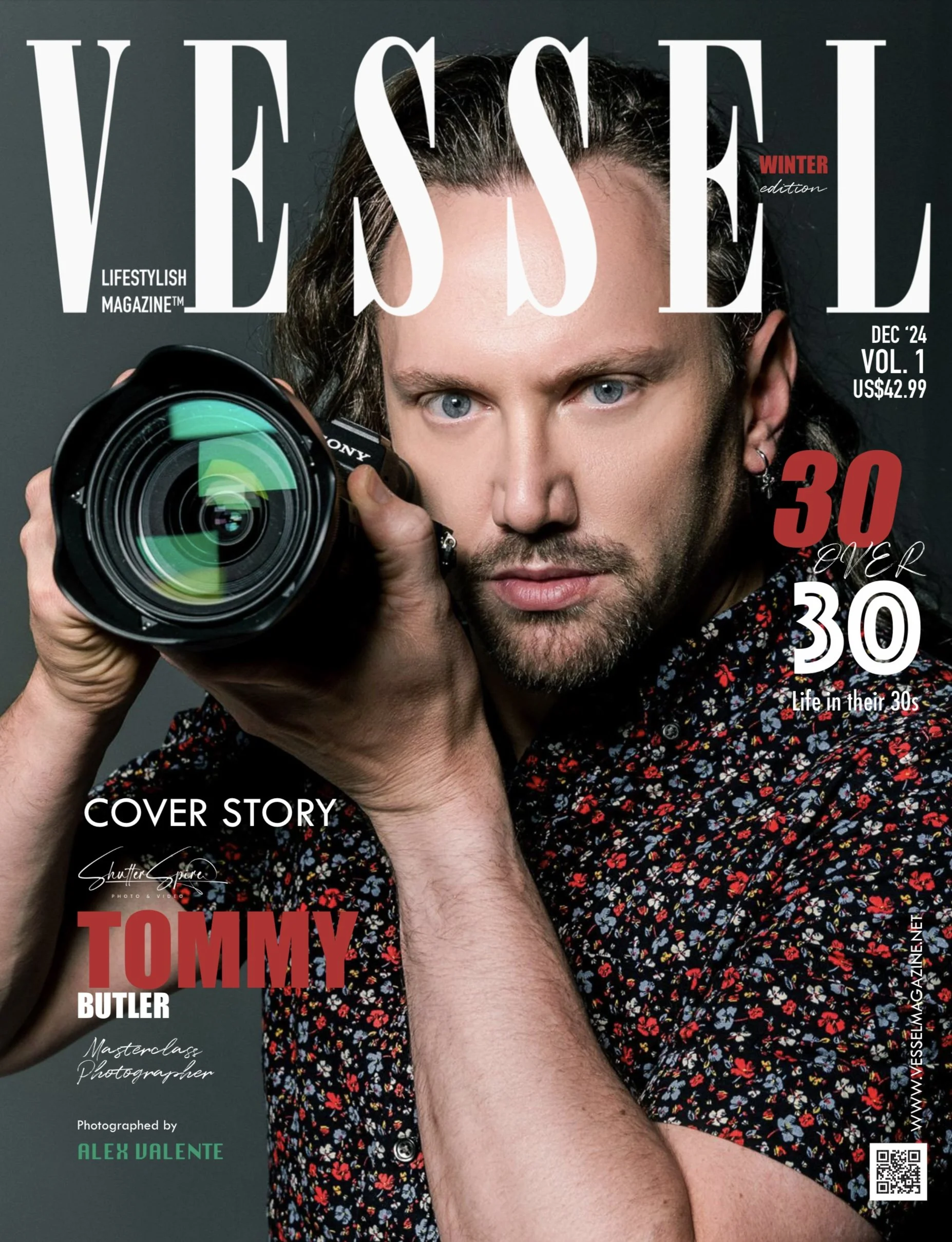MASTERCLASS PHOTOGRAPHER
TOMMY BUTLER
On this brisk Monday afternoon, Tommy and I had carefully reserved the day for our much-anticipated cover story interview, connecting seamlessly via a virtual platform. The quiet hum of our surroundings set a reflective tone as we settled before our screens, each ready to dive into an engaging dialogue. With a shared sense of purpose, the conversation began to unfold with a natural ease, weaving through stories, insights, and reflections that brought Tommy’s journey to life in a way only the magic of storytelling can.
VESSEL: Could you start by giving us a brief introduction to yourself?
Tommy: Well, I want to talk a little bit about how I do things differently than most people. But we’ll get to that later. By way of introduction, I’m Tommy. I like it when people call me Tommy. I don’t like being formal—just call me Tommy. Even little kids call me Tommy, and I love it. It feels very endearing.
I’ve been a photographer for a number of years. I love visual arts, literary arts, and art in all its different forms. I look for art everywhere I go. I believe there’s a little bit of beauty to be found in everything, so I’m always chasing after it. I’ve got a family here in Utah. I came to Utah during the pandemic to take care of some family issues for members of my extended family who found themselves in a bit of trouble. We came to the rescue. After being here for a while, we fell in love with the beautiful landscapes and all the amazing places you can hike, especially the mountains. So, we stayed, bought a house, and have been here for a few years in Nibby—a tiny little cul-de-sac where life is slow, things are quiet, the kids can play outside with the dogs, and I don’t have to worry. It’s just a beautiful, simple life.
I also really enjoy the creative community here in Utah. I think it’s a beautiful thing that we’re all working so hard to build. I’m totally here for that. As for my career, I’m a manager of a data science team for one of the world’s largest financial firms. I’ve had a 25-year career in IT—it’s been very decorated and celebrated. But it’s not what makes my heart beat or my soul vibrate. It’s nice, and it’s been lucrative. I’m very good at it. But the thing that truly makes me happy, fulfills me, and brings me the greatest joy is the pursuit of the visual arts and the journey of discovering our hearts.
VESSEL: How would you describe your photography style, from landscape, to fashion and portraits? Tell us a little bit about your vision.
Tommy: This is the part of the conversation I really want to focus on. This is the meat and potatoes—where the rubber meets the road. This is the value differentiator. This is everything to me. I could sit here and talk for hours about camera rules and the science behind what makes an image visually pleasing. But the reason, the why behind everything I do, lies in the answer to this question: what makes my photography different?
The thing that sets my photography apart—the approach, the style—is that there isn’t a style. There’s no predetermined style. There’s love. There’s a deep and abiding passion for the person who comes in front of my camera. The difference between me and other photographers is that I don’t worry about my style at all. I focus entirely on finding the authentic truth of the person in front of me. I work to uncover their soul. If I can capture their energy and what makes them uniquely beautiful—just them—and magnify it, then what we end up with is a beautiful picture or set of pictures. Because every person is different, every one of my photoshoots looks different. Sure, there will be a cohesive editing style, but across all the subject matter I shoot, there’s a tremendous visual diversity. That’s because I’m not doing the same thing every time. I don’t go into a photoshoot with my idea of how it should go. Instead, I take the time to study the individual before we ever meet. I’ll look at a few photos they send me and study: Who is this person? What are they like? What makes them tick? I’ll research any information they’ve shared about themselves online—not stalking, of course, just observing. If possible, I’ll meet with them beforehand, maybe over lunch, to talk, ask questions, and figure out who they are. What makes them happy? What excites them? What terrifies them? What makes them them?
Once I understand that, I have a much better idea of how to photograph them in a way that complements their soul and conveys their story—their humanity and beauty as an individual. That means sometimes I’ll shoot someone in black and white. Other times, I’ll use dramatic colors, a lavish set, or a beautiful natural landscape. Maybe I’ll take a harpist to a golden field in autumn. Maybe I’ll photograph an athlete in the gym. It all depends on the individual.
The way I shoot is by following the energy of the person—capturing who they are and what makes them their own authentic self. And what we end up with is content that just slaps. The photography is visually resplendent. People often ask, “What did you do to get this photo?” The answer isn’t what they expect. For example, I was once doing an athletic photo shoot at a fitness seminar. The session was structured with a canned set of poses we were supposed to follow. But one individual wasn’t clicking with the setup. The poses weren’t working. So, I stopped. I paused the shoot and talked to them. That’s when I learned they were a dancer, not just a boxer. Instead of throwing punches, I told them, “I want you to start leaping for me.” Suddenly, we had magic. Magic happens when you let someone be who they are.
That’s the heart of my photography—my style, my passion, my true love. It lies in discovering what makes each individual uniquely beautiful. At any age, from any background, with any person—any beautiful soul—we uncover what makes them who they are and shine a magnifying glass on it. The result might look radically different from the last shoot or the one before that. But what we end up with is magic. Truly magic.
To read the full interview with Tommy Butler, get your copy of this issue in print or digital format.









